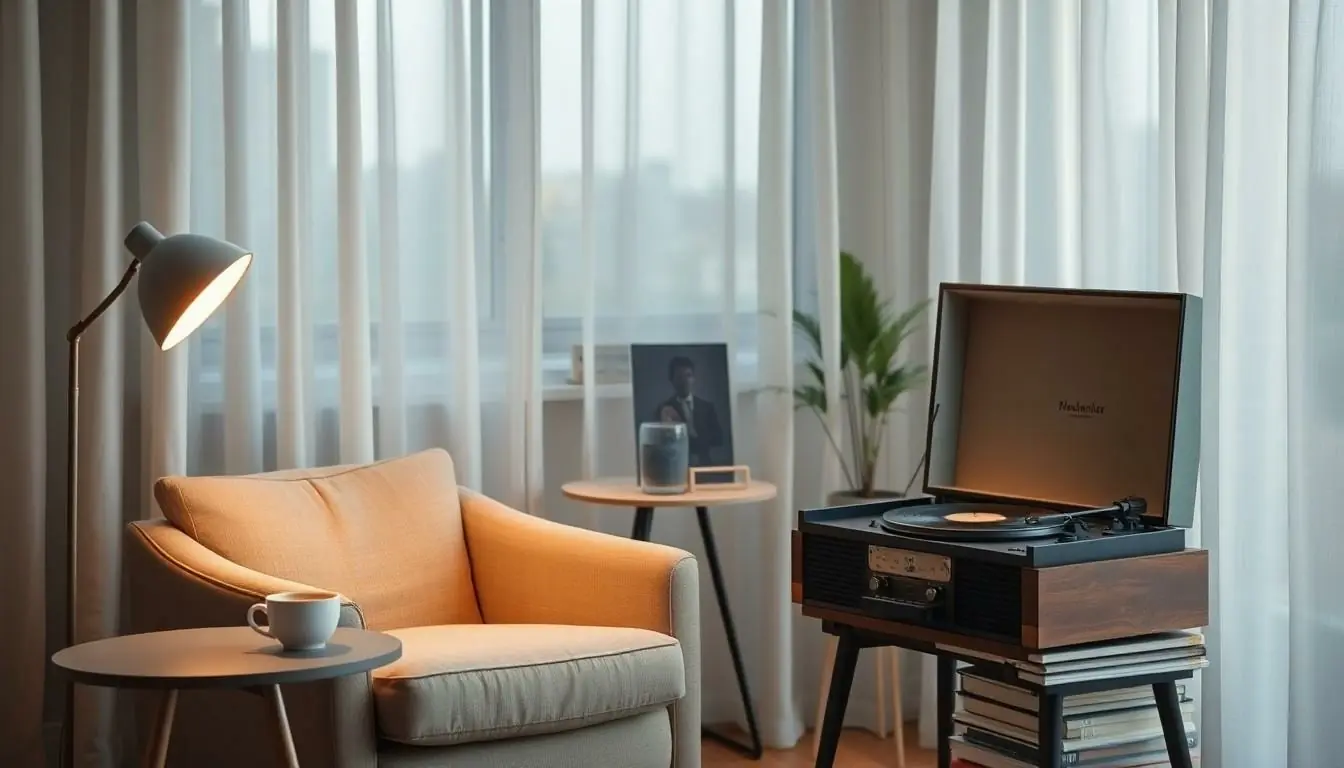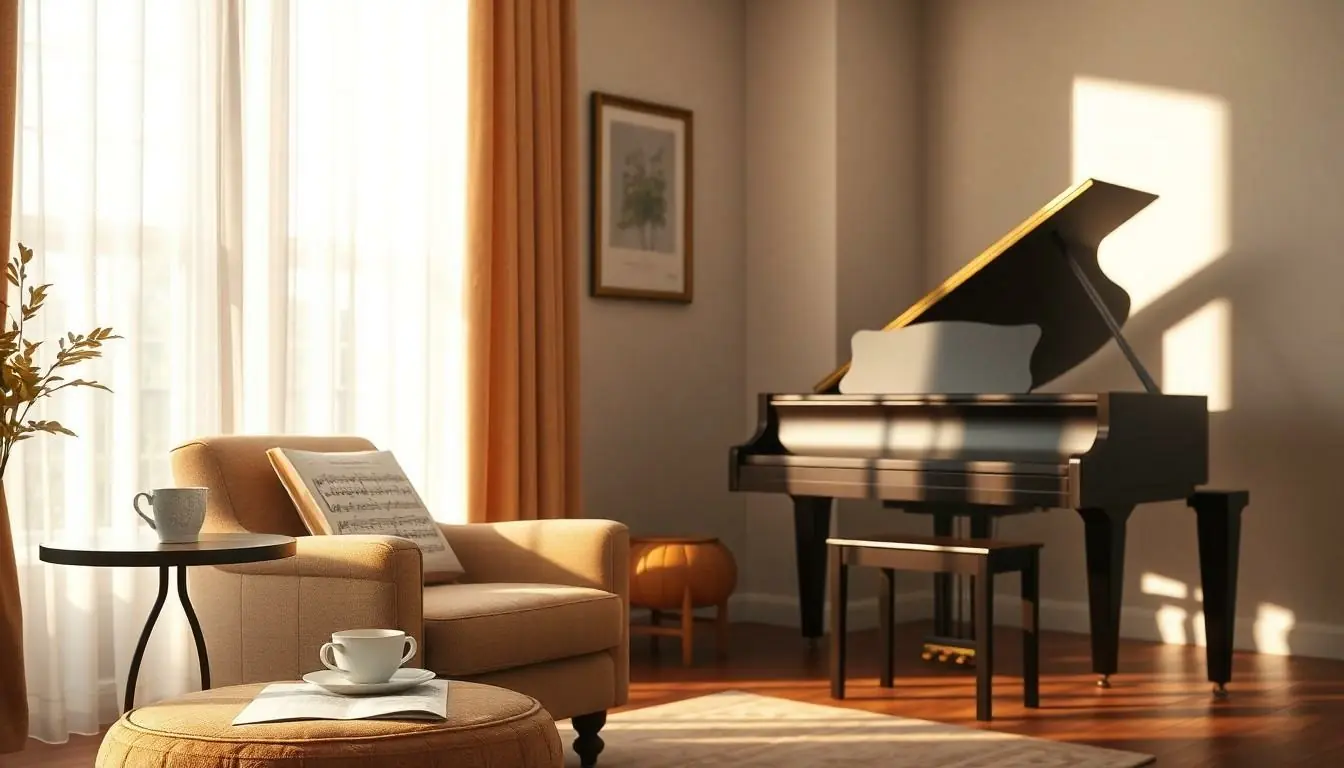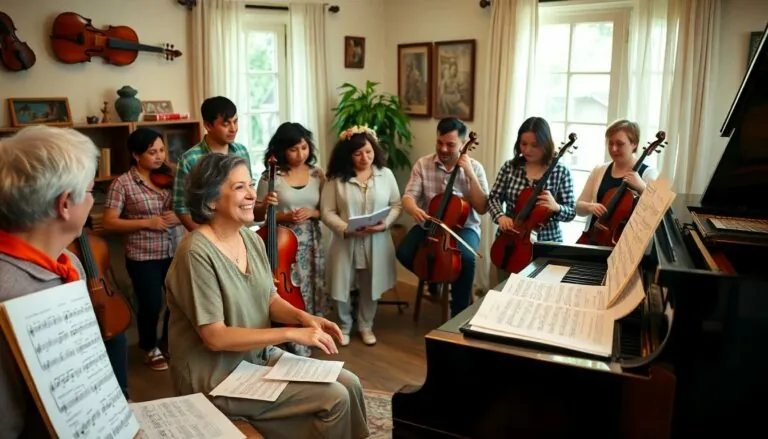Table of Contents
ToggleIn a world buzzing with chaos and noise, quiet classical music offers a soothing escape. Picture this: you’re nestled in a cozy corner, a cup of tea in hand, and the gentle strains of a piano sonata wrap around you like a warm blanket. It’s the perfect antidote to the daily grind, transforming any mundane moment into a serene experience.
But wait—who says classical music has to be stuffy and serious? Quiet classical tunes can be both elegant and playful, inviting listeners to relax while chuckling at the absurdity of life. Whether it’s a delicate string quartet or a soft symphony, these melodies create a tranquil backdrop that makes even the busiest days feel like a leisurely Sunday afternoon. So, let’s dive into the world of quiet classical music and discover how it can elevate everyday moments into something truly magical.
Overview Of Quiet Classical Music
Quiet classical music brings tranquility to listeners through its gentle melodies. It encompasses a variety of composers and styles, each contributing to a calming atmosphere. Renowned pieces, such as Erik Satie’s “Gymnopédies” or Claude Debussy’s “Clair de Lune,” illustrate an ethereal quality that resonates deeply with audiences.
The essence of quiet classical music often lies in its simplicity. Minimalistic approaches create an intimate environment, ideal for relaxation. Soft piano sonatas and subtle string quartets encourage mindfulness, allowing individuals to drift into a state of peace. Compositions featuring silence between notes amplify emotional depth, emphasizing the beauty within restraint.
Instrumentation plays a critical role in shaping soundscapes. Strings, woodwinds, and soft piano notes evoke serene moods, engaging listeners’ senses. Performances focus on dynamics, creating space for silence and emphasizing delicate sounds. This attention to detail invites contemplation and fosters a deeper appreciation for the music.
Quiet classical music often finds application in diverse settings. Background ambient music in spas, yoga studios, and meditation spaces enhances relaxation. Additionally, its presence in film soundtracks evokes emotional responses, guiding viewers through narrative arcs.
Ultimately, this musical genre cultivates a peaceful experience in daily life. Through its rich history and distinctiveness, quiet classical music serves as a source of solace. Balancing fluid harmonies with gentle rhythms transforms mundane moments into serene encounters, encouraging individuals to pause and reflect.
Benefits Of Listening To Quiet Classical Music

Quiet classical music offers numerous advantages for listeners. This genre promotes relaxation and a sense of calm, making it ideal for various situations.
Stress Relief
Quiet classical music significantly lowers stress levels. Research shows that listeners experience reduced heart rate and lower blood pressure. Gentle melodies create a soothing environment, allowing individuals to unwind after a hectic day. Engaging with pieces like Satie’s “Gymnopédies” can induce a meditative state, enhancing overall well-being. Many people find that incorporating this type of music into their daily routine fosters a sense of tranquility. Stress relief often leads to improved emotional health and productivity.
Enhanced Focus
Listening to quiet classical music can improve concentration. This genre provides an unobtrusive background that encourages sustained attention. Studies indicate that soft instrumental pieces stimulate brain activity, making tasks feel more manageable. While working or studying, many individuals find that playing quiet classical music helps drown out distractions, allowing for deeper thinking. The rhythmic and melodic structures also inspire creativity and enhance cognitive performance. Altogether, creating a focused atmosphere significantly boosts productivity in various professional and personal settings.
Popular Quiet Classical Music Compositions
Quiet classical music features compositions that evoke tranquility and introspection. Many composers excel in creating calm and serene environments.
Notable Composers
Erik Satie stands out with his minimalist style, crafting pieces like “Gymnopédies” that invite relaxation. Claude Debussy, known for his impressionistic approach, creates atmospheric works such as “Clair de Lune.” These composers, alongside others like Frédéric Chopin and Max Richter, establish gentle melodies that provoke thought and contemplation. Their works resonate deeply, providing listeners with soothing soundscapes.
Recommended Pieces
“Gymnopédies No. 1” by Erik Satie offers a delicate simplicity. Debussy’s “Clair de Lune” evokes a sense of wonder and calm. Additionally, Chopin’s “Nocturne in E-flat Major” is perfect for unwinding after a busy day. Max Richter’s “On the Nature of Daylight” beautifully intertwines emotion and serenity. Other recommended pieces include Ludovico Einaudi’s “Nuvole Bianche” and Arvo Pärt’s “Spiegel im Spiegel,” both of which enhance moments of introspection.
How To Incorporate Quiet Classical Music Into Daily Life
Quiet classical music enhances daily interactions and promotes tranquility. Integrating this genre requires thoughtful consideration of environments and musical selections.
Listening Environments
Listening environments play a crucial role in experiencing quiet classical music optimally. Spas create serene spaces, allowing gentle melodies to enhance relaxation. Home offices provide focused atmospheres, where soft tunes stimulate productivity without distraction. Cafes often use quiet classical music to establish calming backgrounds, inviting customers to unwind. Living rooms become intimate retreat areas when filled with soothing soundscapes. Even outdoor settings, such as gardens, benefit from this genre’s ability to create peaceful moments amid nature.
Creating Playlists
Creating playlists ensures listeners can easily access their favorite quiet classical pieces. Consider selecting tracks based on mood, such as those for relaxation or focus. Including a variety of composers, like Satie, Debussy, and Einaudi, results in a rich listening experience. Aim for a mix of well-known pieces and hidden gems, providing diversity while maintaining tranquility. Length also matters; a 1-2 hour playlist accommodates activities like working, meditating, or unwinding. Regularly updating playlists keeps the experience fresh and allows exploration of new compositions within the same soothing framework.
Quiet classical music offers a unique refuge from the hectic pace of modern life. Its gentle melodies create an inviting atmosphere that encourages relaxation and introspection. By integrating these soothing compositions into daily routines, individuals can experience a profound sense of calm and clarity.
Whether it’s through carefully curated playlists or simply allowing the music to play softly in the background, the benefits are undeniable. This genre not only enhances focus but also promotes emotional well-being. Embracing quiet classical music can transform ordinary moments into serene experiences, enriching everyday life with tranquility and grace.






